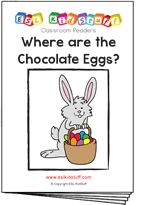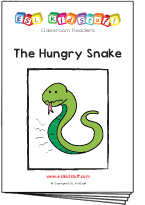Easter lesson plan
Stand-alone lesson ESL kids lesson plan
Lesson plans for ESL kids teachers
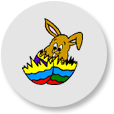
Easter
In this lesson, students are introduced to some common Easter vocabulary, make an Easter card and an Easter craft and, of course, play lots of fun games, including an Easter egg hunt.
Members get accompanying flashcards, worksheets, song and classroom reader.
Download materials:
Our lesson plans are FREE!
Sign up for accompanying:
✔ worksheets
✔ homework sheets
✔ craft sheets
✔ flashcards
✔ song downloads & videos
✔ classroom readers & videos
Click to see lesson details, materials and supplies
Time: 40 mins – 1 hour
Objectives: Recognize and identify 6 Easter words and 3 prepositions of location.
Structures: “Happy Easter”, “Where is the Easter egg?”, “It’s in / on / under (the cup)”, “Do you like …?”, ” Yes, I do”, “No, I don’t”.
Target vocabulary: Easter egg, Easter bunny / rabbit, chocolate, basket, ears, tail.
Lesson materials
Flashcards:
- Easter bunny
Printables:
- Find the Easter eggs worksheet
- [hide_on_uk]Color[/hide_on_uk][hide_on_us]Colour[/hide_on_us] the Easter egg worksheet (for younger learners) or Easter egg [hide_on_uk]color[/hide_on_uk][hide_on_us]colour[/hide_on_us] code worksheet (for older kids)
- Pin the tail to the rabbit sheet
- Reader worksheet
Songs:
- The Easter song
Readers:
- Where are the chocolate eggs?
Additional materials:
- Easter egg craft sheet
Supplies:
- [hide_on_uk]colored[/hide_on_uk][hide_on_us]coloured[/hide_on_us] crayons / pencils
- lots of mini-Easter Eggs
- baskets for collecting eggs
- glue
- construction paper / card (white and pink) cut into headbands and ears
- felt
- cotton balls
- face, ears and body parts
- device to play the song on
During the lesson, students will collect mini-Easter eggs, so a good supply of mini-eggs and a basket to collect them in will be needed.
There are also a couple of crafts and activities that require some pre-class preparation (see these sections below: Make craft: Easter bunny ears, Play “Pin the tail on the Easter rabbit” and Make “Easter cards” craft for parents).
Lesson procedure:
Warm up and maintenance:
1. Greetings
Start the lesson as you usually would (E.g. The hello song, “What’s your name?”, “How are you?”, homework check, etc.).
2. Make craft: Easter bunny ears
Your students are going to make cute bunny ears headbands to wear in class!
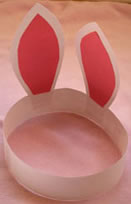
Before class: prepare the shapes: cut a strip of card for the headband and two ear shapes (including pink inner ears) per student. Construct one headband for you to show and wear in class.
In class: tell your students that today is a special lesson – an Easter lesson! Show a picture of the Easter bunny. Teach “Easter bunny” and “ears”. Take out the craft which you had made before the class and put it on your head. Tell your students they are going to make the same craft.
Give out the headband strips and ear shapes to your students and let them decorate the headband and ears with crayons, markers, glitter, etc.
Finally, measure the headband on each student’s head and glue or staple in place and glue on the ears. Your students can now wear this for the duration of the lesson!
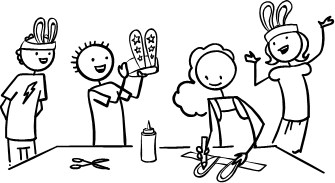
3. Sing “The Easter song”
Now that you have made your rabbit ears let’s have some fun being rabbits! First teach the two gestures: hopping around like a rabbit and looking for Easter eggs. Then play the song and have everyone hop around and have fun.
Lyrics for “The Easter song”
Chorus:
Easter rabbit, Easter rabbit,
Comes when I’m in bed,
Easter rabbit, Easter rabbit,
Hiding chocolate eggs.
Verse 1:
Look in the garden (garden)
Look in the living room (living room)
Look in the kitchen (kitchen)
Look everywhere!
Where are the chocolate eggs?
Chorus
Verse 2:
Look in the bedroom (bedroom)
Look in the dining room (dining room)
Look in the bathroom (bathroom)
Look everywhere!
Where are the chocolate eggs?
Verse 3:
I’ve found my chocolate eggs!
I’ve found my chocolate eggs!
Yummy! Yummy! Yummy! Yummy!
Chocolate eggs!
Gestures for “The Easter song”
The actions for this song are very simple, fun and energetic – lots of hopping around like a rabbit!
Everyone stands up for the song:
- For the chorus, everyone hops around the classroom like a rabbit
- For the verses, pretend to be looking for Easter eggs (gesture with palm of hand over eyes)
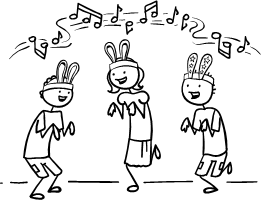
[hide_on_uk]Short sample (members get full-length song):
[/hide_on_uk]
[hide_on_us]Short sample (members get full-length song):
[/hide_on_us]
New learning and practice:
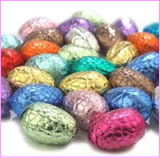
1. Teach new vocabulary: Easter egg, chocolate, basket
Take out the Easter bunny picture again. Point to the Easter eggs in the bunny’s basket and ask what they are and teach / elicit: “Easter egg”. Take out a mini-Easter egg (the type which is covered in [hide_on_uk]colorful[/hide_on_uk][hide_on_us]colourful[/hide_on_us] foil). Teach / elicit: “Easter egg” and “chocolate”. Elicit the [hide_on_uk]colors[/hide_on_uk][hide_on_us]colours[/hide_on_us] of the foil. Take out a small basket (or even a paper box is fine) and teach “basket”. Put the egg in the basket.
2. Teach / Review “Do you like ~”, “Yes, I do”, “No, I don’t”
Take off the foil wrapper and show the chocolate egg. Say, “Yummy!”. Then say, “I like chocolate!”, and eat the Easter egg, all the time saying “yummy!”.

At this point your students will probably be clamoring for an egg. Give out a little basket (simple paper boxes are also fine) to each student. Pull out another egg (it is probably a good idea to have them hidden somewhere, e.g. in a large pocket) and ask one student, “Do you like chocolate?”. Teach / Elicit, “Yes, I do” (or “No, I don’t” in the unlikely event that someone doesn’t like chocolate!). Continue with all the students – only giving the eggs to kids who answer correctly (come back to the ones who made a mistake later). Don’t let your student eat the eggs – they have to collect and keep in their baskets to take home.
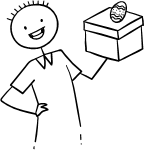
3. Teach / Review prepositions of location “in”, “on”, “under”
Take out a small box and elicit / teach “box”. Put an egg in the box.
Ask “Where is the Easter egg?”. Teach “It’s in the box”. Chorus this phrase 3 times.
Next teach / elicit “on” and “under” the box (each time chorusing 3 times). Then do a check by putting the egg in, on and under the box and asking your students where the egg is. Do with a few more objects in place of the box (e.g. pencil case, book, etc.).
4. Play “Preposition Easter egg hunt”
Now to practice the prepositions to find some Easter eggs! Before class, hide around 4 eggs per student all around the classroom – in drawers, on shelves, under cushions … anywhere you can think of (try to remember where they are!).
Say to one student, “Look in / on / under (the book)” (you can point). The student can go and look and then find the egg and put in his/her basket. Do twice for each student so that everyone has collected two eggs each.
Finally, explain that there are two more eggs per student hidden in the classroom. Let everyone go off hunting (but they must each stop after finding two more eggs). As your students are hunting you can help them out by giving more directions using prepositions.
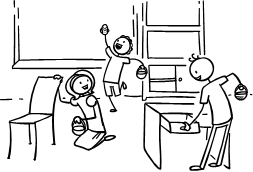

5. Do “Find the Easter eggs” worksheet
This is a nice worksheet which mirrors the Easter egg hunt activity your students just did. Give all the students the worksheet and have them follow the lines and [hide_on_uk]color[/hide_on_uk][hide_on_us]colour[/hide_on_us] the Easter eggs. As they are working, ask individual students questions (e.g. What’s this?, What [hide_on_uk]color[/hide_on_uk][hide_on_us]colour[/hide_on_us] is it?, etc.).
6. Read classroom reader “Where are the chocolate eggs?”
This classroom readers ties in perfectly with the Easter egg hunt and worksheet your students have just finished.
Before class, download and print off the reader “Where are the chocolate eggs?”. As you go through each page, point to the pictures and ask where the Easter Egg is hidden, helping with vocabulary:
Teacher: Where is the chocolate egg? (with kitchen page open)
Students: The oven!
Teacher: Yes, that’s right! Is it on the oven?
Students: No, in the oven!
Teacher: Yes, good job! The chocolate egg is in the oven!
Get the students really involved in the story by asking lots of questions (e.g. eliciting the objects and the colors of the eggs).
After reading the story, give out a reader worksheet to each student and have everyone complete the exercise. Then go through the answers as a class.
Alternatively, watch our video version of the reader (Internet connection required).
7. Play “Pin the tail on the Easter rabbit”
Create the rabbit sheet (make one of your own or use our sheet) and have blindfolded students tape the cotton ball tail onto the rabbit. Mini-Easter eggs can be given out as prizes!
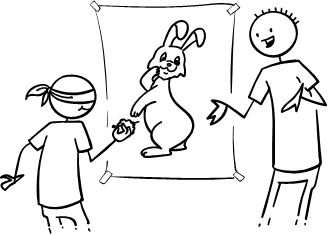
8. Make “Easter cards” craft for parents
You can easily make these in class with some construction paper, felt and common craft supplies.

Before class: cut out enough card for each student for the actual card. Also, cut out the green grass for each student and different [hide_on_uk]colored[/hide_on_uk][hide_on_us]coloured[/hide_on_us] oval shapes for the eggs. Finally, cut out strips of felt for the ribbons and small circles to stick on the eggs.
In class: have your students glue the felt onto the cards. Older kids can write an Easter message inside the card and for smaller kids you can help them write their own message (even get them to trace over a message written lightly in pencil).
A nice idea is to have each student give their card to their parents after the lesson (in an envelope if you can stretch your budget far enough!).
Wrap up:
1. Assign homework: “[hide_on_uk]Color[/hide_on_uk][hide_on_us]Colour[/hide_on_us] the Easter egg worksheet” for younger learners or “Easter egg [hide_on_uk]color[/hide_on_uk][hide_on_us]colour[/hide_on_us] code worksheet” for older kids.
First model how to do the worksheet and then give out the worksheets and have your students put them away in their bags.
2. Do your usual end of class routine
Tidy up, put away things in bags, sing “The goodbye song“, etc.
3. Sing “The Easter song” one more time.
Everyone hops around has fun.
4. Quick check
As each student goes to the door to leave the classroom show them a mini-Easter egg and ask a question (e.g. Do you like chocolate? What [hide_on_uk]color[/hide_on_uk][hide_on_us]colour[/hide_on_us] is it? Where is it?).
If they get the word right, they can win the egg and leave. If wrong, they have to go to the back of the line and try again.
Other lesson plans
Actions, verbs & tenses:
- Can – for ability
- Morning routines
- Daily routines & times of the day
- Actions – Present continuous
- Future plans using “going to”
- Past tense activities – Regular verbs
- Past tense activities – Irregular verbs: Part 1
- Past tense activities – Irregular verbs: Part 2
Adjectives:
- Describing people
- Describing things
- Comparing things (Comparative adjectives)
- Comparing things (Superlative adjectives)
Adverbs:
Alphabet:
Animals:
Body:
Classroom:
Clothes:
Colors:
Colours:
Directions:
Family:
Feelings & emotions:
Food:
Health & sickness:
Holidays & festivals:
Jobs:
Likes, dislikes & favorites:
Likes, dislikes & favourites:
- Likes & dislikes
- [hide_on_uk]Favorites[/hide_on_uk][hide_on_us]Favourites[/hide_on_us] and asking why
Nature & Our world:
Numbers:
Places & where we live:
Prepositions of location:
Pronouns:
Shapes:
Shopping:
Sports:
Time, days, months, seasons:
Toys:
Transport & travel:
Weather:


